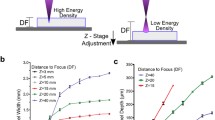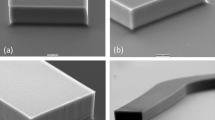Abstract
In this article we demonstrate a simple yet robust rapid prototyping manufacturing technique for the construction of autonomous microfluidic capillary systems by means of CO2 laser processing. The final packaging of the microfluidic device is demonstrated using thermal lamination bonding and allows for a turnaround time of approximately 30 min to 3 h from activation of the laser system to device use. The low-cost CO2 laser system is capable of producing repeatable microfluidic structures with minimum feature sizes superior than 100–150 μm over channel depths of more than 100 μm. This system is utilised to create capillary pump and valve designs within poly (methyl methacrylate) (PMMA) substrates. Such components are part of advanced systems that can self initiate and maintain the flow of various volumes of fluids from an input to a collection reservoir, whilst also controlling the progression of the flow through the various demonstrated valve type structures. The resulting systems could prove a very useful alternative to traditional, non-integrated, fluidic actuation and flow control systems found on-chip, which generally require some form of energy input, have limited portable capabilities and require more complex fabrication procedures.






Similar content being viewed by others
References
Irawan R, Tjin SC, Fang X, Fu CY (2007) Integration of optical fiber light guide, fluorescence detection system, and multichannel disposable microfluidic chip. Biomed Microdevices 9:413–419
Iverson BD, Garimella SV (2008) Recent advances in microscale pumping technologies: a review and evaluation. Microfluid Nanofluid 5:145–174
Jönsson C, Aronsson M, Rundström G, Pettersson C, Mendel-Hartvig I, Bakker J, Martinsson E, Liedberg B, MacCraith B, Ohman O, Melin J (2008) Silane-dextran chemistry on lateral flow polymer chips for immunoassays. Lab Chip 8(7):1191–1197
Juncker D, Schmid H, Drechsler U, Wolf H, Wolf M, Michel B, Rooij N, Delamarche E (2002) Autonomous microfluidic capillary system. Anal Chem 74:6139–6144
Klank H, Kutter JP, Geschke O (2002) CO2-laser micromachining and back-end processing for rapid production of PMMA-based microfluidic systems. Lab Chip 2:242–246
Laser DJ, Santiago JG (2004) Topical review: a review of micropumps. J Micromech Microeng 14:R35–R64
Leu TS, Chang PY (2004) Pressure barrier of capillary stop valves in micro sample separators. Sens Actuators A 115(2–3):508–515
Malek CGK (2006a) Laser processing for bio-microfluidics applications (part I). Anal Bioanal Chem 385(8):1351–1361
Malek CGK (2006b) Laser processing for bio-microfluidics applications (part II). Anal Bioanal Chem 385(8):1362–1369
Man PF, Mastrangelo CH, Burns MA, Burke DT (1998) Microfabricated capillarity-driven stop valve and sample injector, Micro Electro Mechanical Systems, MEMS 98. In: Proceedings of the Eleventh Annual International Workshop, 45–50, ISSN: 1084-6999, Print ISBN: 0-7803-4412-X
Mohammed MI, Abraham E, Desmulliez MPY (2013) Rapid laser prototyping of valves for microfluidic autonomous systems. J Micromech Microeng 23:035034
Nayak NC, Lam YC, Yue CY, Sinha AT (2008) CO2-laser micromachining of PMMA: the effect of polymer molecular weight. J Micromech Microeng 18:095020
Qi H, Wang X, Chen T, Ma X, Zuo T (2009) Fabrication and characterization of a polymethyl methacrylate continuous-flow PCR microfluidic chip using CO2 laser ablation. Microsyst Technol 15:1027–1030
Saha AA, Mitra SK, Tweedie M, Roy S, McLaughlin J (2009) Experimental and numerical investigation of capillary flow in SU8 and PDMS microchannels with integrated pillars. Microfluid Nanofluid 7:451–465
Song H, Wang Y, Pant K (2011) System-level simulation of liquid filling in microfluidic chips. Biomicrofluidics 5:024107
Wang H, Meng S, Guo K, Liu Y, Yang P, Wei Zhong W, Liu B (2008) Microfluidic immunosensor based on stable antibody-patterned surface in PMMA microchip. Electrochem Commun 10:447–450
White FM (1991) Viscous fluid flow, 2nd edn. McGraw-Hill, New York
Zimmermann M, Schmid H, Hunziker P, Delamarche E (2007) Capillary pumps for autonomous capillary systems. Lab Chip 7:119–125
Zimmermann M, Hunziker P, Delamarche E (2008) Valves for autonomous capillary systems. Microfluid Nanofluid 5(3):395–402
Author information
Authors and Affiliations
Corresponding author
Rights and permissions
About this article
Cite this article
Mohammed, M.I., Desmulliez, M.P.Y. The manufacturing of packaged capillary action microfluidic systems by means of CO2 laser processing. Microsyst Technol 19, 809–818 (2013). https://doi.org/10.1007/s00542-013-1792-1
Received:
Accepted:
Published:
Issue Date:
DOI: https://doi.org/10.1007/s00542-013-1792-1




